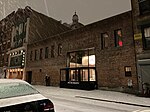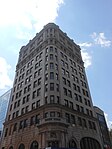St. Teresa Church (Manhattan)

The Church of St. Teresa is a Roman Catholic parish located at 16-18 Rutgers Street on the corner of Henry Street in the Lower East Side neighborhood of Manhattan, New York City. The parish is under the authority of the Archdiocese of New York. The church building was constructed in 1841-42 as the Rutgers Presbyterian Church erected in the Gothic Revival style on a plot of ground donated by Colonel Henry Rutgers, and it is said to have oldest public clock in New York City. The church was taken over by St. Teresa's Parish in 1863, only three years after it was founded.A special feature of the New York Times in 1901 mentioned the church among other Catholic structures in the Lower East Side of Manhattan, describing the group "for the most part...limit[ing] themselves to the functions of a parish church, in districts where social needs are otherwise supplied."The AIA Guide to New York City describes the church as “An ashlar church in the tradition of the others nearby, which antedate 1850. This one conducts services in three languages: English, Spanish and Chinese.”
Excerpt from the Wikipedia article St. Teresa Church (Manhattan) (License: CC BY-SA 3.0, Authors, Images).St. Teresa Church (Manhattan)
Rutgers Street, New York Manhattan
Geographical coordinates (GPS) Address External links Nearby Places Show on map
Geographical coordinates (GPS)
| Latitude | Longitude |
|---|---|
| N 40.713505555556 ° | E -73.990483333333 ° |
Address
St. Teresa's Church
Rutgers Street
10002 New York, Manhattan
New York, United States
Open on Google Maps








